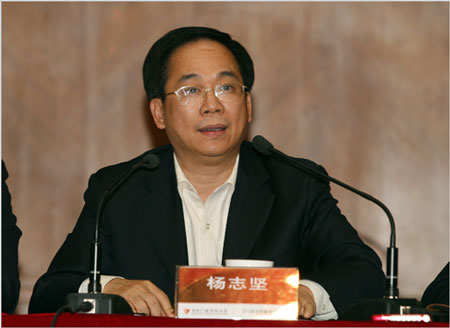 On December 16, 2010, the Open University of China (OUC, formerly China Central Radio & TV University, CCRTVU) held a staff meeting, at which OUC President Yang Zhijian made a report on his achievements, reflected on the past five months since his inauguration, unfolded a blueprint for building the open open university, and put forward his hopes for the future of the OUC. All the members of the OUC leadership and more than 300 staff members attended the meeting, which was chaired by Vice President Ruan Zhiyong of the OUC.
On December 16, 2010, the Open University of China (OUC, formerly China Central Radio & TV University, CCRTVU) held a staff meeting, at which OUC President Yang Zhijian made a report on his achievements, reflected on the past five months since his inauguration, unfolded a blueprint for building the open open university, and put forward his hopes for the future of the OUC. All the members of the OUC leadership and more than 300 staff members attended the meeting, which was chaired by Vice President Ruan Zhiyong of the OUC.

The new president made retrospect and prospect.
First of all, President Yang reviewed the major work done since he was appointed as the new president of the OUC, and his understanding and thoughts on the open university. He said that the founding of radio and television universities (RTVUs) broke new ground for distance higher education in China, and established their historical role. With the past 30 years of efforts made by the CCRTVU and other local RTVUs all over the country, a large operational system covering the whole country has come into being, and a great number of professionals who were "retainable and practical" have been trained for government work and especially the grass-roots units. Meanwhile, the influence of the system has gone on growing. He expressed his great pride in this powerful system.
President Yang pointed out that the social value of RTVUs had been fully demonstrated in the past 30 years of development. The RTVUs in their early stages had offered opportunities for receiving higher education by way of compensatory education for more young people who could not go to university, which was highly regarded by the general public and indeed the whole world. Diplomas issued by the RTVUs were one of the few academic diplomas internationally acknowledged at that time. In 1999, open education was initiated as a pilot program, and enrollment was increased from 30,000 in its early days to over three million now, making its due contribution to the mass higher education in China. The RTVUs had done what was urgent at that time for the country with limited national resources and at a very low cost. Meanwhile, the RTVUs had adhered to the "Four Orientations" (oriented towards the needs of local areas, grass-roots units, rural areas, remote areas and regions inhabited by ethnic groups), paid close attention to special groups and made great efforts to promote equal access to education through the "One-College-Student-for-One-Village Scheme", education for the disabled, education for non-commissioned officers and soldiers and community education. He reiterated that as the National Outline for Medium and Long-term Education Reform and Development had stated we should "make a good job of building open universities" and the major task for the OUC in the near future is to build the open universities.
On the construction of open universities, President Yang set forth three "fives". They are "five trains of thoughts", "five focuses" and "five reform priorities". The "five trains of thoughts" include: (1) to build open universities on the basis of the OUC and local open universities by integrating the related resources; (2) to build open universities with the support of modern information technology and with the Internet as a key carrier to facilitate the formation of a digitalized learning environment; (3) to build open universities by energetically developing non-degree continuing education as the key and steadily developing degree continuing education; (4) to build open universities by adhering to the traditional "Four Orientations" of RTVUs and promoting equality in education; (5) to build open universities by making the enhancement of learners' ability as the core and deepening education and teaching reform. The "five focuses" include: (1) to set up a powerful network platform accessible from all directions; (2) to step up the construction of learning resources; (3) to strengthen team construction, including the three teams of full-time and part-time teachers, administrators, and people engaged in service and research and development; (4) to build a credit bank; (5) to advance international strategy. The "five reform priorities" include: (1) the reform of training modes; (2) the reform of learning modes; (3) the reform of management modes; (4) the reform of the system and its mechanisms; (5) the reform of quality guarantee systems. He pointed out that with ten years of hard work the open universities will be built into an important pillar of a learning society, into a new kind of mega-university in the system of higher education institutions in China, and into the first class of world open universities at an advanced level, all with Chinese characteristics.
President Yang put forward three hopes for the future development of open universities. The first is to seize opportunities and to blaze new trails in a pioneering spirit; the second is to define priorities, to clarify thoughts and to make steady development; the third is to unite as one, to work hard and to reach a higher level. He hoped that all the staff members would keep on stepping up their study efforts to grasp the trends and essence of the development of education reform. They should learn about the development of distant education at home and abroad and widen their horizons by referring to materials, reading documents and making field studies, and they should follow and know the latest developments in information technology and distance education technology.
By Li Lingqun, the OUC